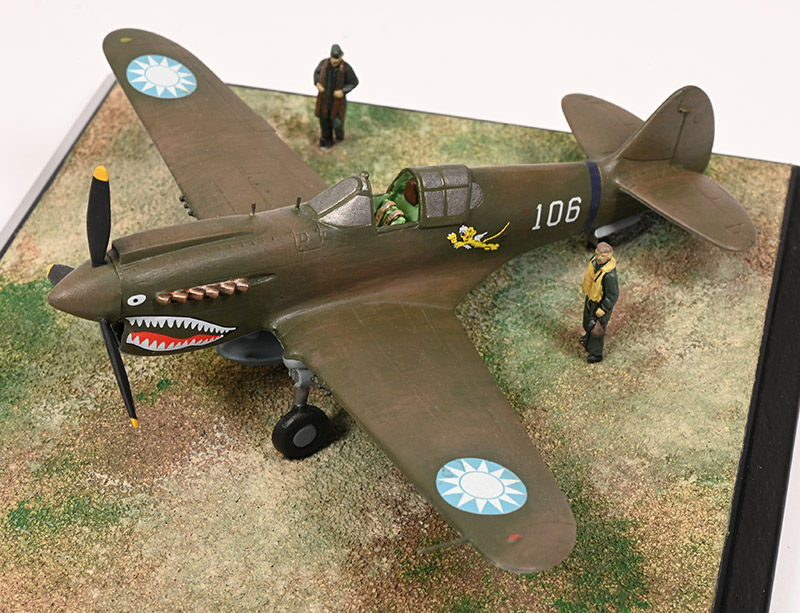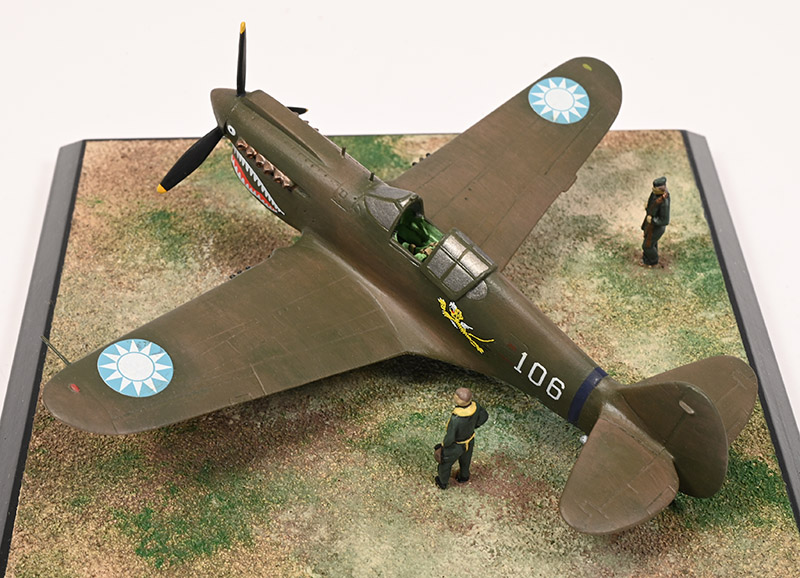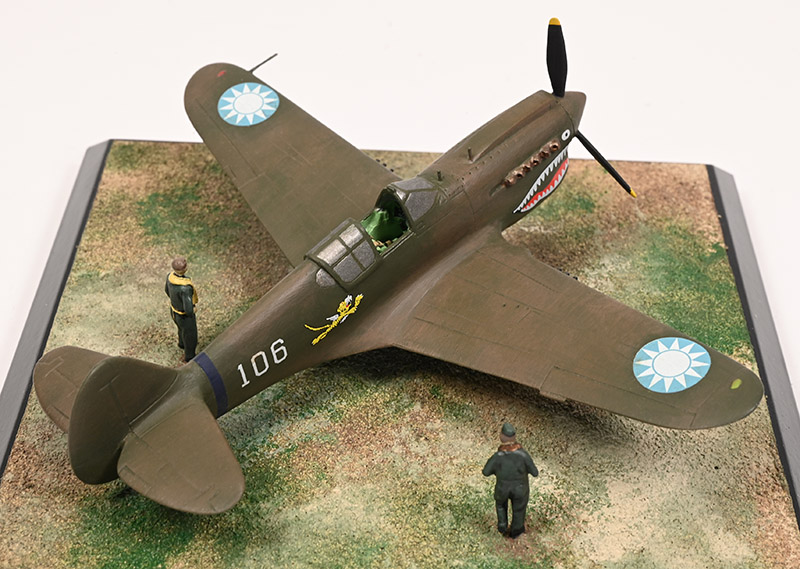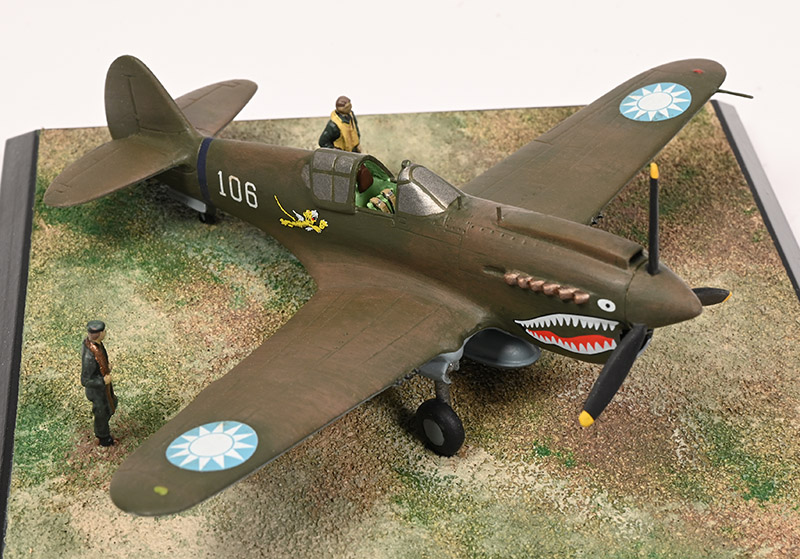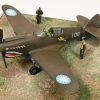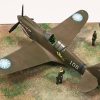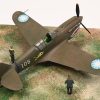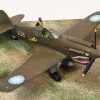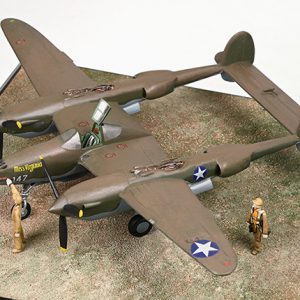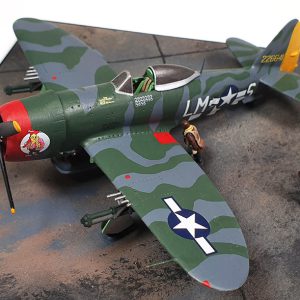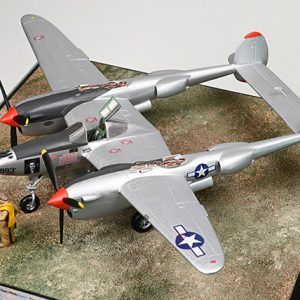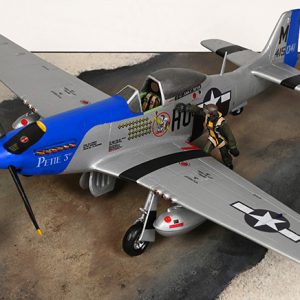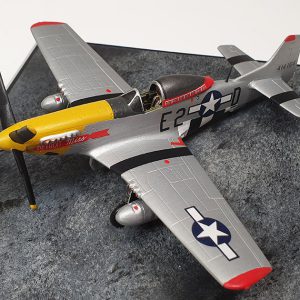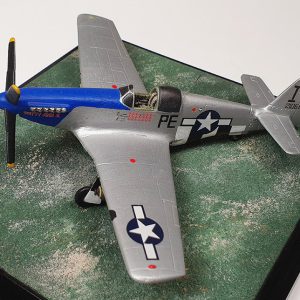Curtiss P-40 E, ‘White 106’
2nd Squadron, American Volunteer Group (AVG), China, 1942
The Curtiss P-40 was developed as an inline-engined version of the Curtiss Hawk 75/P-36 fighter of the late 1930s, the new powerplant being an Allison V-1710 of just over 1,000 hp. The Americans, when they used a name rather than a designation, called all the variants Warhawk; early versions up to the P-40 C were known to the RAF, who used them mostly in the Middle East, as the Tomahawk, and it was this variant that was, in the main, flown against the Japanese in China by the celebrated “Flying Tigers”. These aircraft were diverted from an RAF Tomahawk order, and wore the “British” green/brown camouflage colours. The Allison engine was particularly suited to low-level operations, and while in the European theatre the aircraft’s usual role was reconnaissance or ground attack, where it earned a reputation as a workmanlike and reliable aircraft, in the Far East, as at Pearl Harbor, it was perforce used as an interceptor. The P-40 E was similar in most respects to the P-40 D, except for a slightly more powerful engine and an extra .50 in (12.7 mm) gun in each wing, bringing the total to six. Some aircraft also had small underwing bomb shackles. The P-40 E was the variant that bore the brunt of air-to-air combat by the type in the key period of early to mid 1942, for example with the first US squadrons replacing the American Volunteer Group (AVG) in China, In fact the AVG was already transitioning to this type from their P-40 B and Cs.
The AVG’s fighter aircraft were painted with a large shark face on the front of the aircraft. This motif was chosen after pilots saw a photograph of a P-40 of No. 112 Squadron RAF in North Africa, which in turn had adopted the shark face from German pilots of the Luftwaffe’s ZG 76 heavy fighter wing. About the same time, the AVG was dubbed “The Flying Tigers” by its Washington support group, called China Defence Supplies. The P-40’s good qualities included pilot armour, self-sealing fuel tanks, sturdy construction, heavy armament, and a higher diving speed than most Japanese aircraft. These qualities could be used to advantage in accordance with the group’s commander Claire Chennault’s combat tactics. Chennault created an early warning network of spotters that would give his fighters time to take off and climb to a superior altitude where this tactic could be executed.
Flight Leader Johnnie Petach was a high-ranking pilot in the 2nd Squadron, AVG. He shot down three enemy bombers on 23rd January, 1942. In April and June 1942 about 50 improved P-40 E fighters came direct from the United States. Petach flew one of these coded white 106. Painted dark olive drab 41 and neutral grey 43, AVG personnel obscured the fuselage US-roundels with dark green paint and applied Chinese insignia on the four wing positions obscuring the pre-existing US markings. In the wartime photo of White 106, AVG personal appear to have overpainted the US Army designator on the bottom of the wings with neutral grey paint. White 106 wears the insignia for the Flying Tigers that was created by cartoonists at Walt Disney Studios.
On 7th May 1942 the Japanese Army began building a pontoon bridge across the upper Salween River, which would allow them to move troops and supplies into China and drive towards Kunming. To stem this tide, 2nd Squadron deployed a flight of their new P-40 Es to bombing and strafing into the Salween River Gorge. During the next four days, the AVG pilots flew continuous missions into the gorge, effectively neutralising the Japanese forces. This prevented a Japanese advance on Kunming and Chungking; the Japanese never advanced farther than the west bank of the upper Salween. Claire Chennault later wrote of these critical missions, “The American Volunteer Group had staved off China’s collapse on the Salween.” Despite being on the defensive thereafter, the AVG continued to harass the JAAF with raids on their Vietnamese air bases.
The US government later decided to assign a regular Air Force unit to China. On 4th July 1942, the AVG passed out of existence, when the Army Air Force took over the job with its 23rd fighter group, commanded by Colonel Robert L. Scott. Almost all of the original Flying Tigers returned home for a well earned rest, but some were needed to stay behind a little longer to help train the newly formed 23rd. Petach was all set and packed to leave when he was asked to remain in China. He was going to return home with the girl he recently married, one of the two AVG nurses, Emma Jane “Red” Foster Petach. He stayed to offer his services. July 10th 1942 was to be his last flight. The mission was an offensive one involving dive bombing and Petach could have refused it, as he remained with the group solely for the purpose of air base defence. Nonetheless he volunteered. The pilot who flew on his wing said Petach’s bomb hit the target but at the same instant his plane exploded, apparently hit by ground fire.


